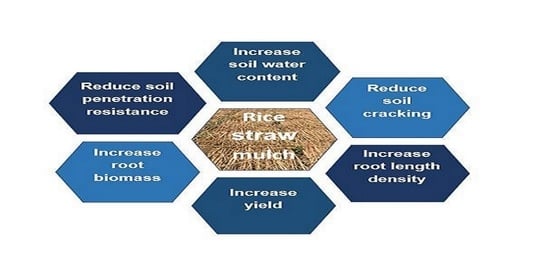Impact of Rice Straw Mulch on Soil Physical Properties, Sunflower Root Distribution and Yield in a Salt-Affected Clay-Textured Soil
Abstract
:1. Introduction
2. Materials and Methods
2.1. Site Description
2.2. Experimental Treatments and Crop Management
2.3. Soil Water Content and Irrigation Water Requirement
2.4. Soil Penetration Resistance
2.5. Soil Crack Dimension
2.6. Root Measurements
2.7. Statistical Analyses
3. Results
3.1. Sunflower Yield and Yield Components
3.2. Soil Water Content
3.3. Soil Penetration Resistance
3.4. Soil Crack Development
3.5. Root Distribution
3.6. Relationships between Soil Factors and Yield
3.7. Effects of Cracks and Soil Penetration Resistance on Root Distribution
4. Discussion
4.1. Soil Water Content, Soil Penetration Resistance and Crack Development
4.2. Root Distribution
4.3. Sunflower Growth and Yield
5. Conclusions
Author Contributions
Funding
Institutional Review Board Statement
Informed Consent Statement
Data Availability Statement
Acknowledgments
Conflicts of Interest
References
- Mondal, M.K.; Paul, P.L.C.; Humphreys, E.; Tuong, T.P.; Ritu, S.P.; Rashid, M.A. Opportunities for cropping system intensification in the coastal zone of Bangladesh. In Proceedings of the CPWF, GBDC, WLE Conference on Revitalizing the Ganges Coastal Zone: Turning Science into Policy and Practices, Dhaka, Bangladesh, 21–23 October 2015; Humphreys, E., Tuong, T.P., Buisson, M.-C., Pukinskis, I., Phillips, M., Eds.; CGIAR Challenge Program on Water and Food (CPWF): Colombo, SriLanka, 2015; pp. 449–476. [Google Scholar]
- Paul, P.L.C.; Bell, R.W.; Barrett-Lennard, E.G.; Kabir, E. Variation in the yield of sunflower (Helianthus annuus L.) due to differing tillage systems is associated with variation in solute potential of the soil solution in a salt-affected coastal region of the Ganges Delta. Soil Tillage Res. 2020, 197, 104489. [Google Scholar] [CrossRef]
- Adachi, T. Effects of rice-soil puddling on water percolation. In Proceedings of the Transactions of the 14th International Congress of Soil Science, Kyoto, Japan, August 1990. [Google Scholar]
- Kirchhof, G.; So, H.; Adisarwanto, T.; Utomo, W.; Priyono, S.; Prastowo, B.; Basir, M.; Lando, T.; Subandi; Dacanay, E.; et al. Growth and yield response of grain legumes to different soil management practices after rainfed lowland rice. Soil Tillage Res. 2000, 56, 51–66. [Google Scholar] [CrossRef]
- Bayhan, Y.; Kayisoglu, B.; Gonulol, E. Effect of soil compaction on sunflower growth. Soil Tillage Res. 2002, 68, 31–38. [Google Scholar] [CrossRef]
- Cambi, M.; Mariotti, B.; Fabiano, F.; Maltoni, A.; Tani, A.; Foderi, C.; Laschi, A.; Marchi, E. Early response of Quercus robur seedlings to soil compaction following germination. Land Degrad. Dev. 2018, 29, 916–925. [Google Scholar] [CrossRef]
- Kozlowski, T.T. Soil Compaction and Growth of Woody Plants. Scand. J. Forest Res. 1999, 14, 596–619. [Google Scholar]
- Cook, S. Soil physical constraints to establishment of mungbeans (Vigna radiata L. Wilczek) in paddy rice (Oryza sativa L.) soils. Soil Tillage Res. 1995, 33, 47–64. [Google Scholar] [CrossRef]
- So, H.; Woodhead, T. Alleviation of soil physical limits to productivity of legumes in Asia. In Proceedings of the International Workshop, Khon Kaen, Thailand, 1–5 September 1987. [Google Scholar]
- Goodman, A.; Ennos, A.R. The Effects of Soil Bulk Density on the Morphology and Anchorage Mechanics of the Root Systems of Sunflower and Maize. Ann. Bot. 1999, 83, 293–302. [Google Scholar] [CrossRef] [Green Version]
- Moslehuddin, A.Z.; Hussain, M.S.; Saheed, S.M.; Egashira, K. Clay mineral distribution in correspondence with agroecological regions of Bangladesh soils. Clay Sci. 1999, 11, 83–94. [Google Scholar]
- Cabangon, R.J.; Tuong, T. Management of cracked soils for water saving during land preparation for rice cultivation. Soil Tillage Res. 2000, 56, 105–116. [Google Scholar] [CrossRef]
- Tuong, T.P.; Cabangon, R.J.; Wopereis, M.C.S. Quantifying Flow Processes during Land Soaking of Cracked Rice Soils. Soil Sci. Soc. Am. J. 1996, 60, 872–879. [Google Scholar] [CrossRef]
- Wopereis, M.; Bouma, J.; Kropff, M.; Sanidad, W. Reducing bypass flow through a dry, cracked and previously puddled rice soil. Soil Tillage Res. 1994, 29, 1–11. [Google Scholar] [CrossRef]
- Ringrose-Voase, A.; Sanidad, W. A method for measuring the development of surface cracks in soils: Application to crack development after lowland rice. Geoderma 1996, 71, 245–261. [Google Scholar] [CrossRef]
- Taylor, H.; Brar, G. Effect of soil compaction on root development. Soil Tillage Res. 1991, 19, 111–119. [Google Scholar] [CrossRef]
- Whitmore, A.P.; Whalley, W.R. Physical effects of soil drying on roots and crop growth. J. Exp. Bot. 2009, 60, 2845–2857. [Google Scholar] [CrossRef] [Green Version]
- Aasegawa, S.; Thangaraj, J.M.; O’Toole, J. Root behavior: Field and laboratory studies for rice and nonrice crops. Soil Phys. Rice 1985, 6, 383. [Google Scholar]
- Jourgholami, M.; Nasirian, A.; Labelle, E.R. Ecological Restoration of Compacted Soil Following the Application of Different Leaf Litter Mulches on the Skid Trail over a Five-Year Period. Sustain. J. Rec. 2018, 10, 2148. [Google Scholar] [CrossRef] [Green Version]
- Paul PL, C.; Bell, R.W.; Barrett-Lennard, E.G.; Kabir, E. Straw mulch and irrigation affect solute potential and sunflower yield in a heavy textured soil in the Ganges Delta. Agric. Water. Manag. 2020, 239, 106211. [Google Scholar] [CrossRef]
- Fang, S.; Xie, B.; Liu, D.; Liu, J. Effects of mulching materials on nitrogen mineralization, nitrogen availability and poplar growth on degraded agricultural soil. New For. 2011, 41, 147–162. [Google Scholar] [CrossRef]
- Mulumba, L.N.; Lal, R. Mulching effects on selected soil physical properties. Soil Tillage Res. 2008, 98, 106–111. [Google Scholar] [CrossRef]
- Lal, R.; Latham, M. Management of soil compaction and soil-water after forest clearing in upland soils of humic tropical Asia. Soil Manag. Humid Cond. Asia Pac. 1987, 5, 273–296. [Google Scholar]
- Mitchell, J.; Cheth, K.; Seng, V.; Lor, B.; Ouk, M.; Fukai, S. Wet cultivation in lowland rice causing excess water problems for the subsequent non-rice crops in the Mekong region. Field Crop. Res. 2013, 152, 57–64. [Google Scholar] [CrossRef]
- Tracy, S.R.; Black, C.R.; A Roberts, J.; Mooney, S.J. Soil compaction: A review of past and present techniques for investigating effects on root growth. J. Sci. Food Agric. 2011, 91, 1528–1537. [Google Scholar] [CrossRef]
- Mondal, M.K.; Saha, N.K.; Ritu, S.P.; Paul, P.L.C.; Sharifullah, A.K.M.; Humphreys, E.; Tuong, T.P.; Rashid, M.A. Optimum sowing window for boro cultivation in the coastal zone of Bangladesh. In Proceedings of the CPWF, GBDC, WLE Conference on Revitalizing the Ganges Coastal Zone: Turning Science into Policy and Practices, Dhaka, Bangladesh, 21–23 October 2015; Humphreys, E., Tuong, T.P., Buisson, M.-C., Pukinskis, I., Phillips, M., Eds.; CGIAR Challenge Program on Water and Food (CPWF): Colombo, SriLanka, 2015; pp. 449–476. [Google Scholar]
- Sarker, K.K.; Hossain, A.; Timsina, J.; Biswas, S.K.; Malone, S.L.; Alam, K.; Loescher, H.W.; Bazzaz, M. Alternate furrow irrigation can maintain grain yield and nutrient content, and increase crop water productivity in dry season maize in sub-tropical climate of South Asia. Agric. Water Manag. 2020, 238, 106229. [Google Scholar] [CrossRef]
- Bandyopadhyay, K.; Mohanty, M.; Painuli, D.; Misra, A.; Hati, K.; Mandal, K.; Ghosh, P.; Chaudhary, R.; Acharya, C. Influence of tillage practices and nutrient management on crack parameters in a Vertisol of central India. Soil Tillage Res. 2003, 71, 133–142. [Google Scholar] [CrossRef]
- Passioura, J.B. Soil conditions and plant growth. Plant Cell Environ. 2002, 25, 311–318. [Google Scholar] [CrossRef]
- Jourgholami, M.; Fathi, K.; Labelle, E.R. Effects of litter and straw mulch amendments on compacted soil properties and Caucasian alder (Alnus subcordata) growth. New For. 2020, 51, 349–365. [Google Scholar] [CrossRef]
- Liu, T.; Wang, B.; Xiao, H.; Wang, R.; Yang, B.; Cao, Q.; Cao, Y. Differentially improved soil microenvironment and seedling growth of Amorpha fruticosa by plastic, sand and straw mulching in a saline wasteland in northwest China. Ecol. Eng. 2018, 122, 126–134. [Google Scholar] [CrossRef]
- So, H.; Ringrose-Voase, A.; Ringrose-Voase, A. Management of clay soils for rainfed lowland rice-based cropping systems: An overview. Soil Tillage Res. 2000, 56, 3–14. [Google Scholar] [CrossRef]
- Garcia-Orenes, F.; Roldan, A.; Mataix-Solera, J.; Cerdà, A.; Campoy, M.; Arcenegui, V.; Caravaca, F. Soil structural stability and erosion rates influenced by agricultural management practices in a semi-arid Mediterranean agro-ecosystem. Soil Use Manag. 2012, 28, 571–579. [Google Scholar] [CrossRef]
- Jordán, A.; Zavala, L.M.; Gil, J. Effects of mulching on soil physical properties and runoff under semi-arid conditions in southern Spain. Catena 2010, 81, 77–85. [Google Scholar] [CrossRef]
- Ostonen, I.; Püttsepp, Ü.; Biel, C.; Alberton, O.; Bakker, M.R.; Lõhmus, K.; Majdi, H.; Metcalfe, D.; Olsthoorn, A.F.M.; Pronk, A.; et al. Specific root length as an indicator of environmental change. Plant Biosyst. Int. J. Deal. all Asp. Plant Biol. 2007, 141, 426–442. [Google Scholar] [CrossRef]
- Grzesiak, M.T.; Ostrowska, A.; Hura, K.; Rut, G.; Janowiak, F.; Rzepka, A.; Hura, T.; Grzesiak, S. Interspecific differences in root architecture among maize and triticale genotypes grown under drought, waterlogging and soil compaction. Acta Physiol. Plant. 2014, 36, 3249–3261. [Google Scholar] [CrossRef] [Green Version]
- Clark, L.; Whalley, W.; Barraclough, P. How do roots penetrate strong soil? Plant Soil 2003, 255, 93–104. [Google Scholar] [CrossRef]
- Atwell, B. Physiological responses of lupin roots to soil compaction. In Structural and Functional Aspects of Transport in Roots; Springer: Dordrecht, The Netherlands, 1989; pp. 251–255. [Google Scholar]
- Croser, C.; Bengough, A.G.; Pritchard, J. The effect of mechanical impedance on root growth in pea (Pisum sativum). I. Rates of cell flux, mitosis, and strain during recovery. Physiol. Plant. 1999, 107, 277–286. [Google Scholar] [CrossRef]
- Goss, M. Effects of Mechanical Impedance on Root Growth in Barley (Hordeum vulgare L.). J. Exp. Bot. 1977, 28, 96–111. [Google Scholar] [CrossRef]

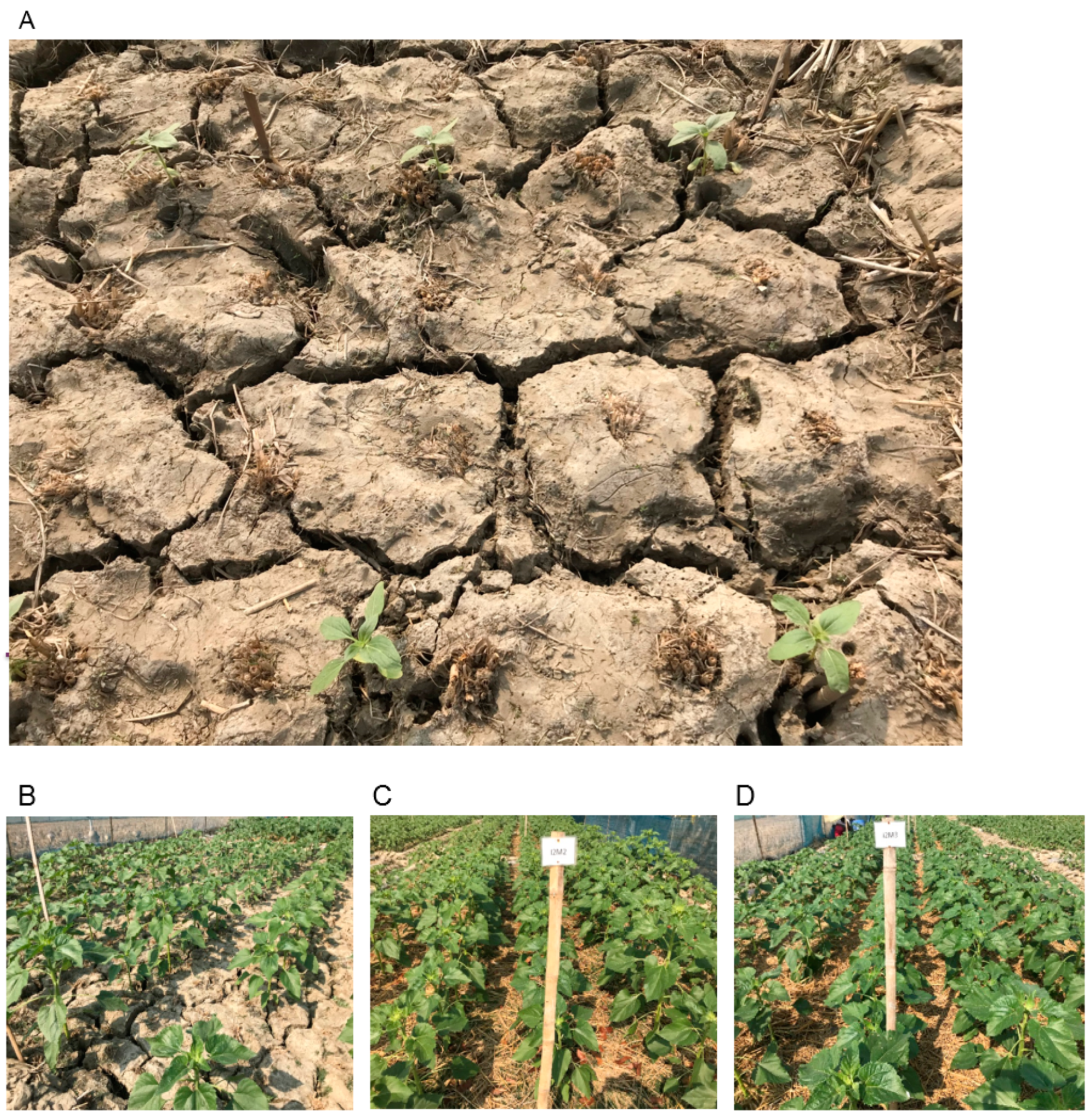
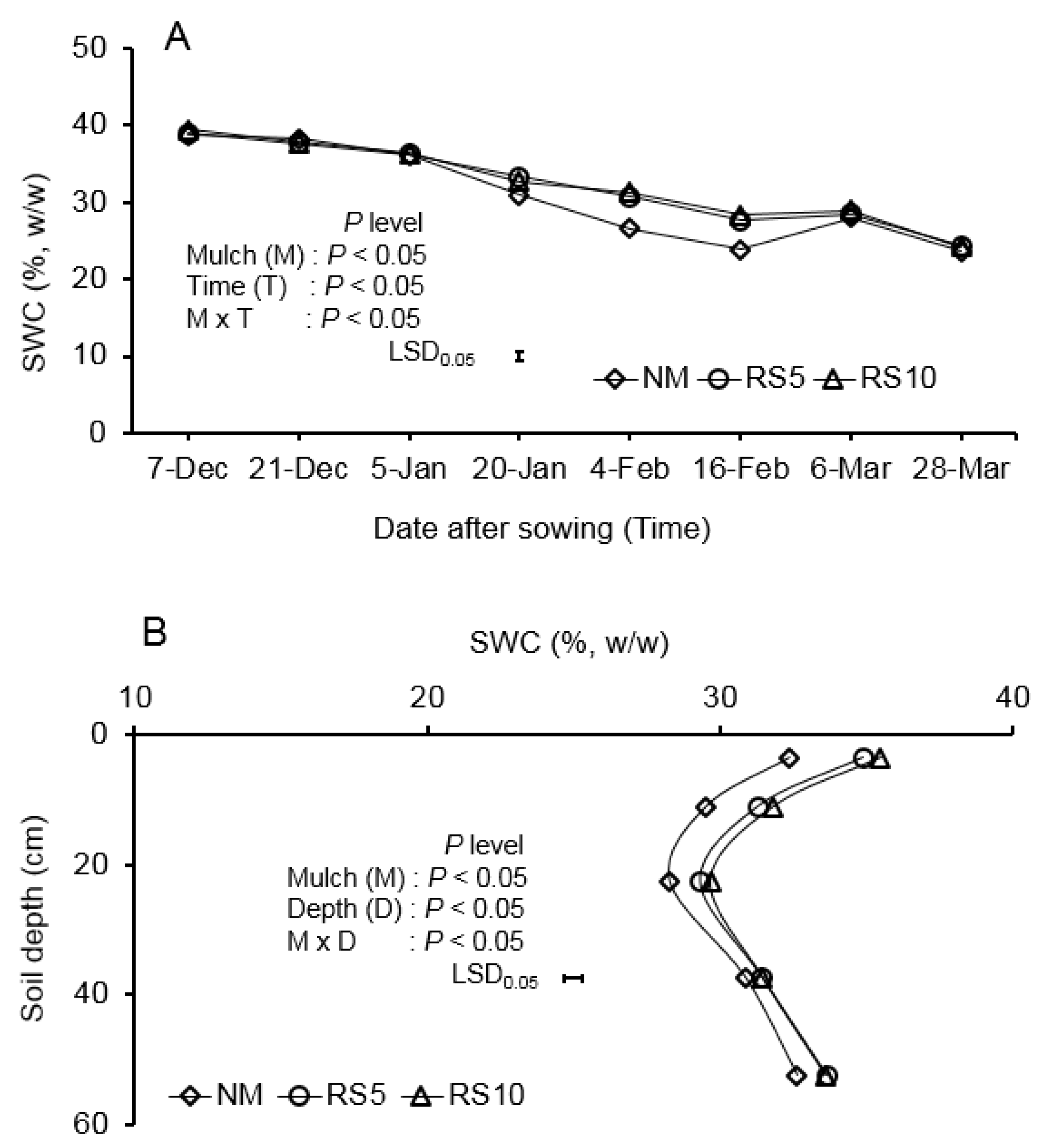

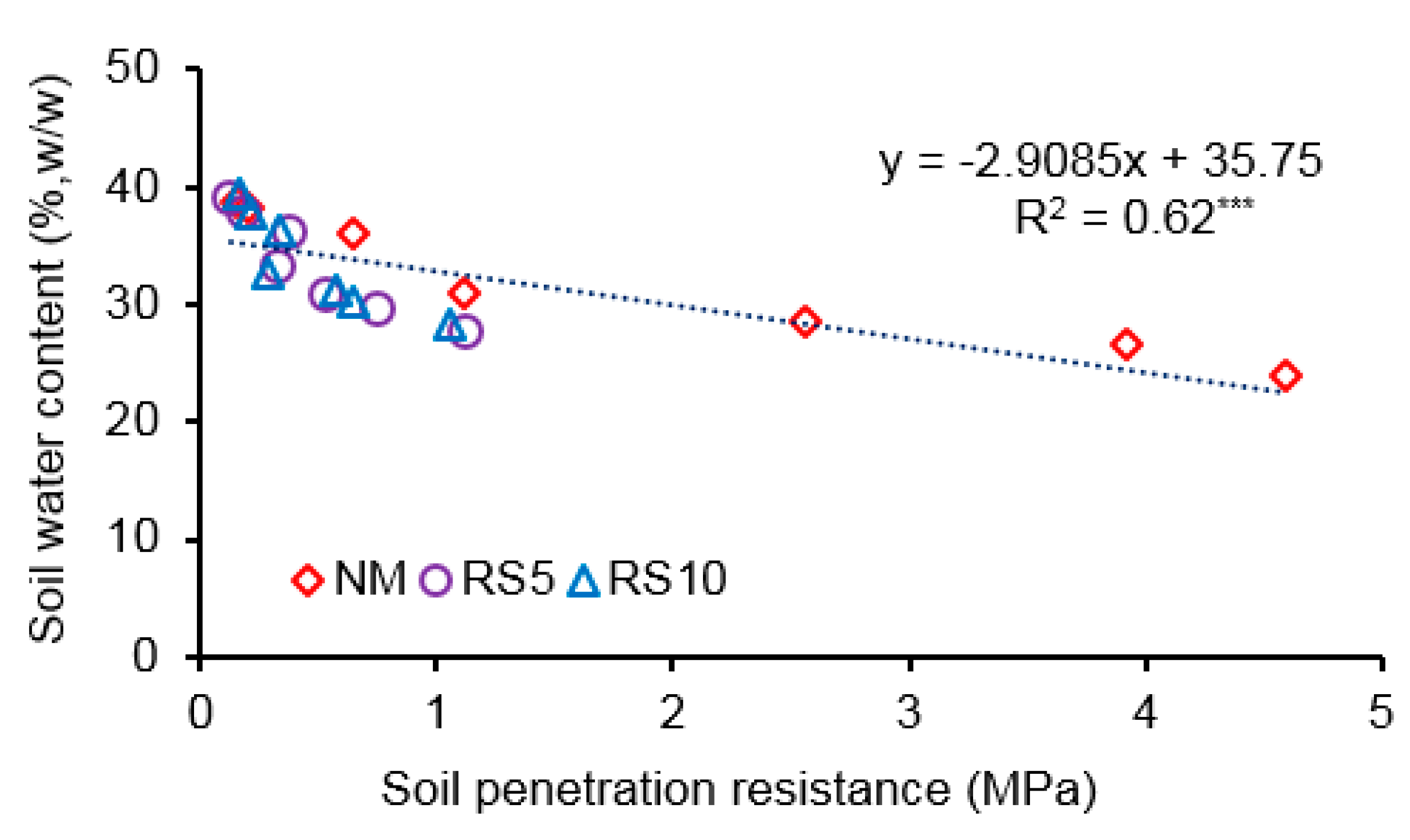


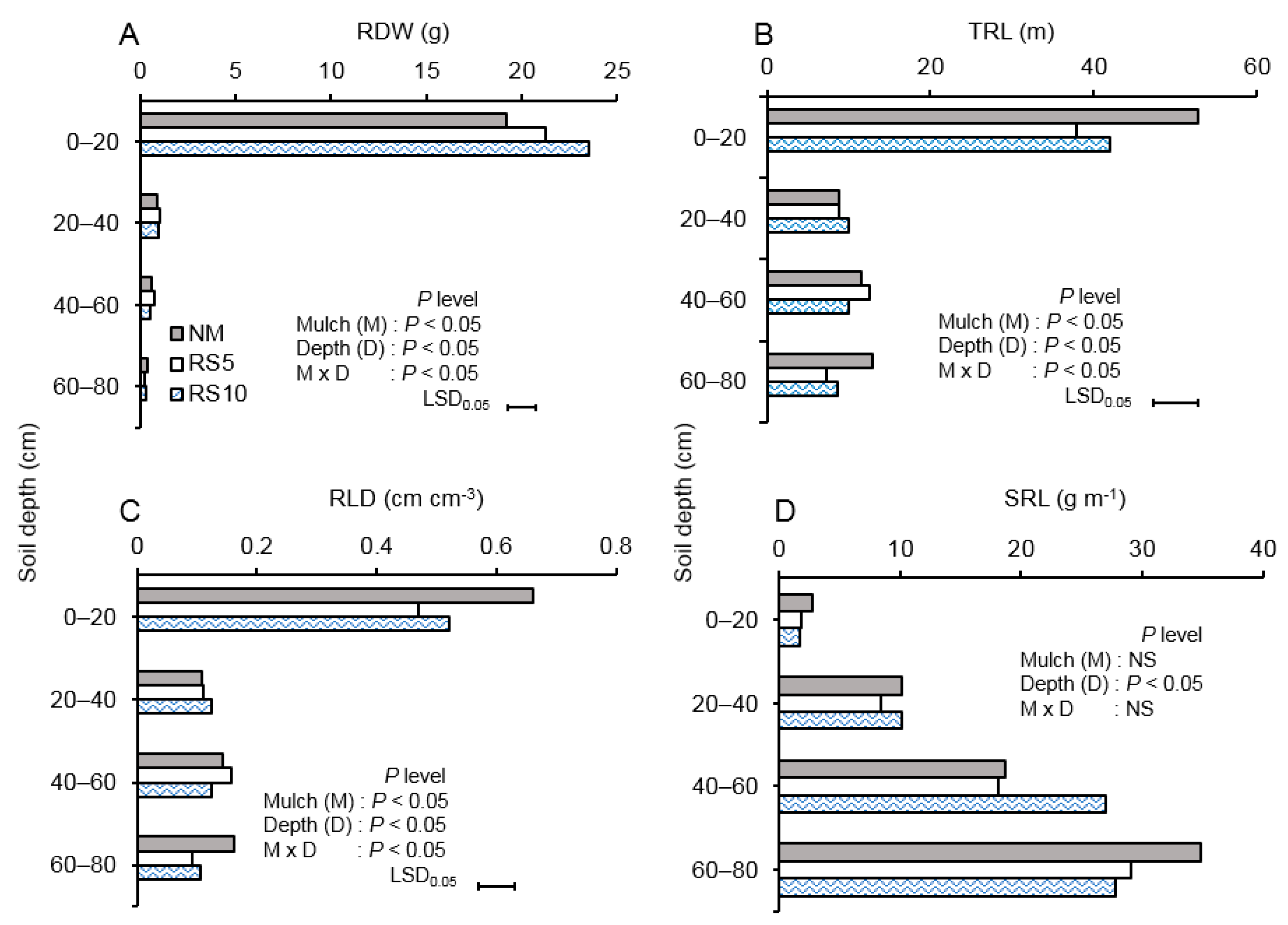

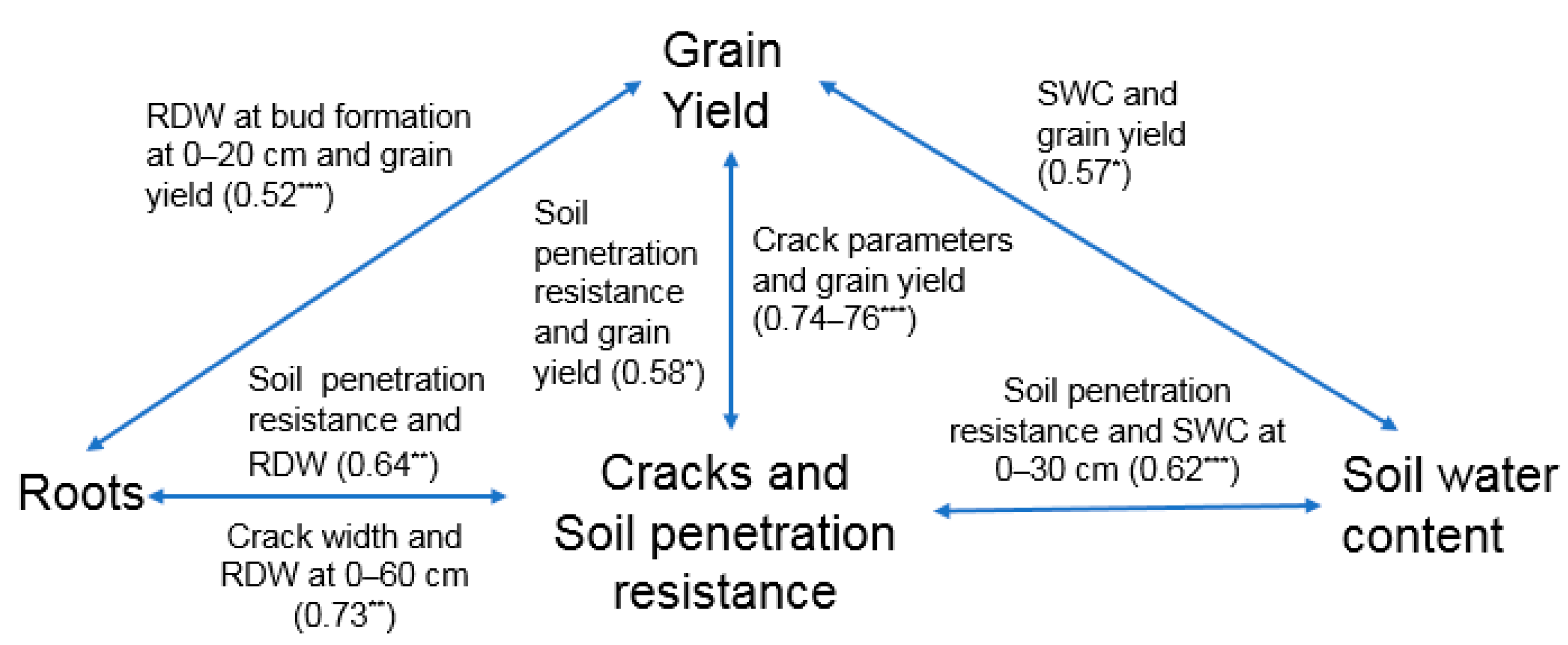
| Depth (cm) | pH | EC1:5 * dS m−1 | Bulk Density (Mg m−3) | Organic C (g kg−1) | Total N (g kg−1) | Extractable | Soil Texture | |||
|---|---|---|---|---|---|---|---|---|---|---|
| P | S | B | Zn | |||||||
| g cm−3 | (mg kg−1) | |||||||||
| 0–15 | 7.1 | 0.38 | 1.39 | 13 | 14 | 3.2 | 88 | 1.3 | 0.80 | Silty clay |
| 15–30 | 7.4 | 0.32 | 1.55 | 9 | 12 | 2.0 | 66 | 1.2 | 0.82 | Silty clay |
| 30–45 | 7.6 | 0.39 | 1.50 | 7 | 11 | 2.5 | 60 | 1.3 | 0.83 | Clay |
| 45–60 | 7.4 | 0.42 | 1.45 | 7 | 10 | 2.6 | 72 | 1.4 | 0.81 | Clay |
| Irrigation Regimes | Mulch Treatments | Yield (t ha−1) | Thousand Seed Weight (g) | Seeds per Head | Head Diameter (cm) |
|---|---|---|---|---|---|
| I1 | RS10 | 3.1 | 82.0 | 1505 | 20.4 |
| RS5 | 3.0 | 81.5 | 1479 | 20.3 | |
| NM | 2.5 | 74.0 | 1285 | 18.6 | |
| I2 | RS10 | 3.3 | 87.0 | 1582 | 21.1 |
| RS5 | 3.2 | 84.5 | 1557 | 20.6 | |
| NM | 2.8 | 79.0 | 1345 | 19.2 | |
| Treatment means | |||||
| I1 | 2.9 | 79.0 | 1423 | 19.8 | |
| I2 | 3.1 | 84.0 | 1495 | 20.3 | |
| RS10 | 3.2 | 85.0 | 1544 | 20.8 | |
| RS5 | 3.1 | 83.0 | 1518 | 20.5 | |
| NM | 2.6 | 76.5 | 1315 | 18.9 | |
| p-values | |||||
| Irrigation | NS | 0.05 | NS | NS | |
| Mulch | 0.05 | 0.05 | 0.01 | 0.05 | |
| Irrigation x Mulch | NS | NS | NS | NS | |
| LSD0.05 | |||||
| Irrigation | - | 2.0 | - | - | |
| Mulch | 0.3 | 6.2 | 109 | 1.3 | |
| Irrigation x Mulch | - | - | - | - | |
| Soil Factors | Correlation Coefficient (r2) | Regression Equation | Co-Efficient Determination (R2) |
|---|---|---|---|
| Soil water content (SWC) | (+) 0.57 * | Y = 0.13 SWC − 1.49 | 0.32 |
| Soil penetration resistance | (−) 0.58 * | Y = −0.50 SR + 3.43 | 0.34 |
| Crack parameters | |||
| Crack length per unit area (LA) | (−) 0.76 *** | Y = −0.104 LA + 3.43 | 0.58 |
| Crack width (W) | (−) 0.75 *** | Y = −0.42 W + 3.65 | 0.57 |
| Crack depth (D) | (−) 0.72 *** | Y = −0.09 D + 3.77 | 0.53 |
| Crack cross-sectional area (A) | (−) 0.74 *** | Y = −446.74 A + 3.35 | 0.56 |
| Crack volume (V) | (−) 0.74 *** | Y = −47.52 V + 3.21 | 0.55 |
| Soil Depth (cm) | At Bud Formation (58 DAS) | At Flowering (90 DAS) | ||||||
|---|---|---|---|---|---|---|---|---|
| p-Levels and r2 Values in Brackets | p-Levels and r2 Values in Brackets | |||||||
| RDW | TRL | RLD | SRL | RDW | TRL | RLD | SRL | |
| 0–20 | *** (0.52) | * (0.31) | * (0.31) | NS | ** (0.34) | NS | NS | * (0.24) |
| 20–40 | NS | * (0.26) | * (0.26) | NS | NS | NS | NS | NS |
| 40–60 | NS | NS | NS | NS | NS | NS | NS | NS |
| 60–80 | - | - | - | - | NS | * (0.22) | * (0.22) | ** (0.35) |
| Crack Parameters | Total Root Dry Weight at Bud Formation | Total Root Dry Weight at Flowering | Total Root Length at Bud Formation | Total Root Length at Flowering |
|---|---|---|---|---|
| p-Levels with r2 Values in Brackets | ||||
| Width (W) | ** (0.73) | NS | NS | NS |
| Length per unit area (LA) | ** (0.72) | NS | * (0.44) | NS |
| Depth (D) | ** (0.68) | NS | * (0.48) | * (0.44) |
| Cross-sectional area (A) | ** (0.67) | NS | * (0.47) | NS |
| Volume (V) | ** (0.66) | NS | * (0.54) | NS |
Publisher’s Note: MDPI stays neutral with regard to jurisdictional claims in published maps and institutional affiliations. |
© 2021 by the authors. Licensee MDPI, Basel, Switzerland. This article is an open access article distributed under the terms and conditions of the Creative Commons Attribution (CC BY) license (http://creativecommons.org/licenses/by/4.0/).
Share and Cite
Paul, P.L.C.; Bell, R.W.; Barrett-Lennard, E.G.; Kabir, E. Impact of Rice Straw Mulch on Soil Physical Properties, Sunflower Root Distribution and Yield in a Salt-Affected Clay-Textured Soil. Agriculture 2021, 11, 264. https://doi.org/10.3390/agriculture11030264
Paul PLC, Bell RW, Barrett-Lennard EG, Kabir E. Impact of Rice Straw Mulch on Soil Physical Properties, Sunflower Root Distribution and Yield in a Salt-Affected Clay-Textured Soil. Agriculture. 2021; 11(3):264. https://doi.org/10.3390/agriculture11030264
Chicago/Turabian StylePaul, Priya Lal Chandra, Richard W Bell, Edward G. Barrett-Lennard, and Enamul Kabir. 2021. "Impact of Rice Straw Mulch on Soil Physical Properties, Sunflower Root Distribution and Yield in a Salt-Affected Clay-Textured Soil" Agriculture 11, no. 3: 264. https://doi.org/10.3390/agriculture11030264
APA StylePaul, P. L. C., Bell, R. W., Barrett-Lennard, E. G., & Kabir, E. (2021). Impact of Rice Straw Mulch on Soil Physical Properties, Sunflower Root Distribution and Yield in a Salt-Affected Clay-Textured Soil. Agriculture, 11(3), 264. https://doi.org/10.3390/agriculture11030264





